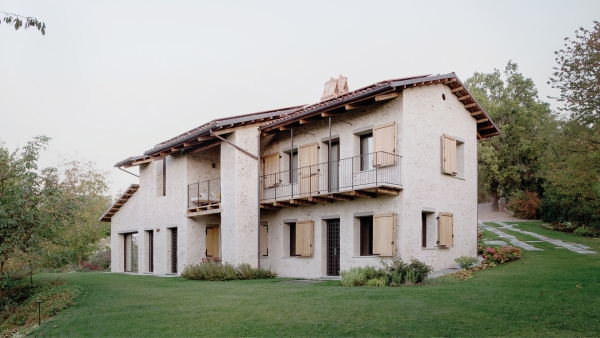【 The London-based design practice transforms a 200-year-old farmstead into a modern home and studio in an idyllic setting in Piedmont, Italy. 】
Cascina, a 200-year-old historic farmstead complex nestled in the Piedmont region of Italy, is not just a renovation project that marries heritage preservation and sustainable design. London-based Jonathan Tuckey Design's approach to the restoration of Cascina commits to retaining the original structures while implementing eco-conscious methods of contemporary intervention. The result is an exquisite transformation of a former agricultural building into a home and studio, providing a renewed domestic character that allows its occupants to savour the sweeping vistas of the vineyard-covered valley below.
The Cascina typology, representative of the Piedmont region, is characterised by the juxtaposition of an agricultural building with large, functional openings alongside a domestic structure with smaller apertures. Over time, the original relationship of the buildings with the landscape and their utilitarian materials were increasingly obscured, particularly due to a renovation in the 1990s. Jonathan Tuckey Design's approach aimed to rediscover and reinstate this character and the connection with the landscape. This involved opening up the facades, stripping back finishes, and providing a clear distinction between working and living spaces.
As is with many rehabilitation projects, sustainability was a fundamental consideration in the renovation of Cascina, and this is evident in the innovative approach to material reuse. Though many elements of the original structure were deemed "beyond redemption," a decision was made to salvage the original barn roof structure. With careful timber engineering and the addition of new components, a new roof was constructed using the skeleton of the former structure. It embraces the original hayloft roof timbers, along with its crude iron straps, plugs, and plates. This approach of layering new components over the old became a pivotal design principle, reflecting the philosophy of the project.
The studio’s commitment to "elegant appropriation" is highlighted in Cascina's renovation. This concept involves taking elements designed for a specific task and enabling them to fulfil that task in a different way, thereby adding a new layer of narrative to the project. The appropriation of the former roof structure in Cascina exemplifies this concept, demonstrating how old elements can be reconfigured physically and figuratively to renew and reconfigure structures.
Sustainability in Cascina extends beyond material reuse. The renovation includes the implementation of renewable energy sources, such as a ground source heat pump and solar panels on the pitched roof. By bringing the building back to its former agrarian appearance and improving its thermal envelope, the studio enhanced its energy efficiency. The choice to insulate the building from the inside and apply granular render to the external walls not only improves overall insulation but also reveals the occasional faces of brick, creating a textured, tactile exterior.
Local chestnut wood was chosen for the external shutters and joinery, not only for its visual appeal but also for its low-carbon footprint. This choice also ties the building elements into the landscape, showcasing a holistic approach to sustainability and material selection.
The warm texture of the hand-crafted plaster continues this tactile language internally, complementing materials such as Luserna stone, timber, and brick, and creating a cohesive material palette that exudes robustness and authenticity. The use of Cocciopesto flooring, which combines lime and sand interspersed with crushed terracotta tiles from the site, demonstrates an inventive approach to integrating old and new materials into a polished finish that respects its context. Jack arch ceilings further reinforce the warmth and add depth to the interiors.
The reconfiguration of Cascina's interior spaces was essential to create a more harmonious and functional living environment. The volumes of the complex are nestled within the sloping topography of the site, and thoughtful adjustments were made to improve circulation and open the space. A reconfigured stair in the entrance hall establishes a stronger connection between different levels. The upper floors were rearranged around a stepped double-level hallway to enhance the ceiling height in the entrance and living areas on the ground floor, mirroring the hilly landscape outside.
The ground level is characterised by open-plan living spaces centred around a fireplace, while the dining room features classical proportions bathed in ample natural light. The kitchen, situated at the end of the house, enjoys eastern light and framed views of the woodland. The former passageway connecting the barn and farmhouse, hidden behind the brick "gelosia" screen, now opens a view corridor to the garden and pool beyond.
The first floor accommodates a gallery that leads to the upper-floor hayloft, a light-filled studio with captivating views of treetops and the Alps. The spa, discreetly tucked behind a wall of umber timber, occupies the former barn basement, where original brick vaults seem to levitate above, creating a striking visual contrast.
New windows were strategically added to the north and east facades, allowing an abundance of natural light and framing unexpected views. Concrete lintels, timber elements, and metal lattice shutters complement the detailing of the restored facades, seamlessly integrating old and new design elements.
In addition to the interior enhancements, a new shaded veranda now faces the pool and garden, while the garage is buried into the landscape to the north of the house and covered in planting, further blending the building with its surroundings.
Through the innovative reuse of materials, a commitment to sustainable strategies, and a deep understanding of the building's historical character, the project successfully revitalises a 200-year-old farmstead. The renewed connection between the building and its landscape, the seamless blending of old and new materials, and the enhancement of energy efficiency all contribute to an extraordinary example of successful adaptive reuse. Jonathan Tuckey Design's transformation of Cascina is a story of renewal, sustainability, and the enduring beauty of architectural heritage.
[ Project info ]
Name: Cascina
Location: Piedmont, Italy
Year of completion: 2023
Design Firm: Jonathan Tuckey Design
________________________________________________________________________________________________________________________________________________________
▪ Source: STIRworld|https://www.stirworld.com/see-features-jonathan-tuckey-design-ties-heritage-and-sustainability-to-create-this-home-in-italy
▪ Words: Pooja Suresh Hollannavar
▪ Photography Credit: © Francesca Iovene


